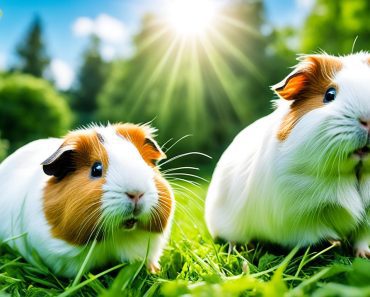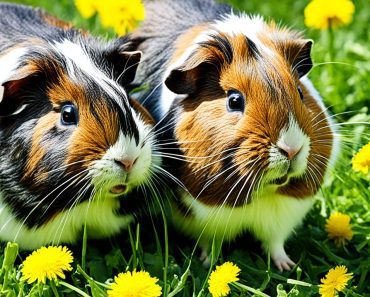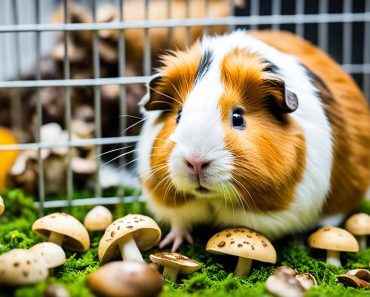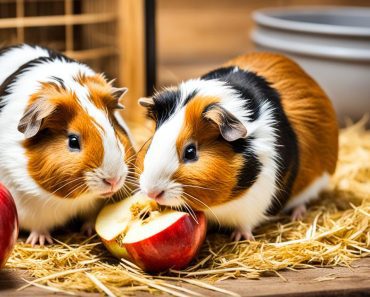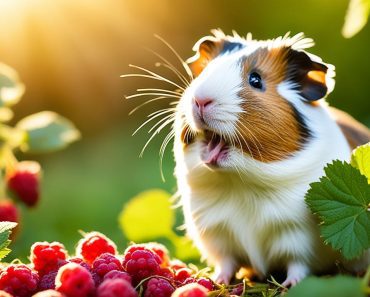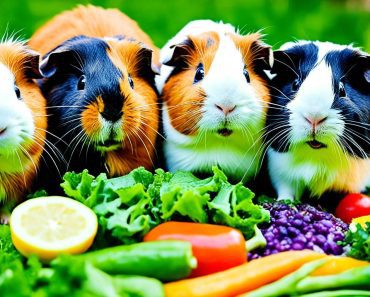As a guinea pig owner, I always strive to provide the best nutrition for my furry friends. One question that often comes to mind is, “Can guinea pigs eat kale?” Well, the answer is yes, they can! Kale is a safe and nutritious addition to a guinea pig’s diet when fed in moderation.
Kale is a leafy green that is packed with essential vitamins and nutrients, making it a great choice for guinea pigs. It contains vitamin A, vitamin C, and calcium, all of which are beneficial for their overall health. However, it’s important to feed kale in limited amounts to prevent overconsumption of certain nutrients that can be harmful to guinea pigs.
Can Guinea Pigs Eat Kale? Yes, but should be given in small amounts.
- Kale is safe for guinea pigs to eat in moderation.
- Kale is rich in vitamin A, vitamin C, and calcium, which support their organ function, immune system, and bone health.
- Wash kale thoroughly to remove any pesticides before feeding it to your guinea pigs.
- Overconsumption of kale can lead to bladder stones and toxicity due to excessive calcium and vitamin A intake.
- Feed kale to guinea pigs two to three times a week in small amounts, alongside a balanced diet of hay and other vegetables.
Vitamins and Nutrients in Kale for Guinea Pigs
Kale is a powerhouse of essential vitamins and nutrients that contribute to the overall health and well-being of guinea pigs. Incorporating kale into their diet can provide numerous benefits, including:
- Vitamin A: Kale is a rich source of vitamin A, which plays a vital role in supporting organ function, promoting healthy eyesight, and strengthening the immune system. This important vitamin helps maintain the health of guinea pigs, ensuring their bodies function optimally.
- Vitamin C: Another important nutrient found in kale is vitamin C. Guinea pigs, like humans, cannot produce their own vitamin C and rely on their diet to meet their requirements. Kale is an excellent source of this essential vitamin, which is necessary for preventing scurvy, boosting immunity, and aiding in the recovery from illness or injury.
- Calcium: Maintaining strong bones is crucial for guinea pigs, and kale can help with that. It contains calcium, a mineral needed for the proper development and maintenance of their skeletal system. However, it is important to note that excessive calcium intake can lead to bladder stones, so moderation is key when including kale in their diet.
In addition to these key nutrients, kale also provides guinea pigs with fiber, potassium, and iron, further enhancing their overall nutrition and well-being.
Benefits and Downsides of Kale for Guinea Pigs
Kale, known as a nutrient-rich superfood, offers numerous health benefits for guinea pigs. It is packed with essential vitamins and minerals that support their overall well-being. The high content of vitamin A in kale promotes healthy organ function and improved eyesight, while vitamin C boosts their immune system and aids in recovery. Additionally, kale offers calcium, which helps maintain strong bones in guinea pigs.
However, it is important to be aware of the potential downsides of kale for guinea pigs. The high calcium content can lead to the formation of bladder stones if consumed excessively. Overconsumption of kale can also result in an excessive intake of vitamin A, which can be toxic to guinea pigs. Therefore, it is crucial to feed kale in moderation and monitor their physical condition to prevent any negative effects.
Feeding kale to guinea pigs as part of a well-balanced diet can offer a range of benefits, but it should be done with caution. Regular monitoring and moderation are key to ensuring that guinea pigs receive the health benefits of kale without experiencing any adverse effects.
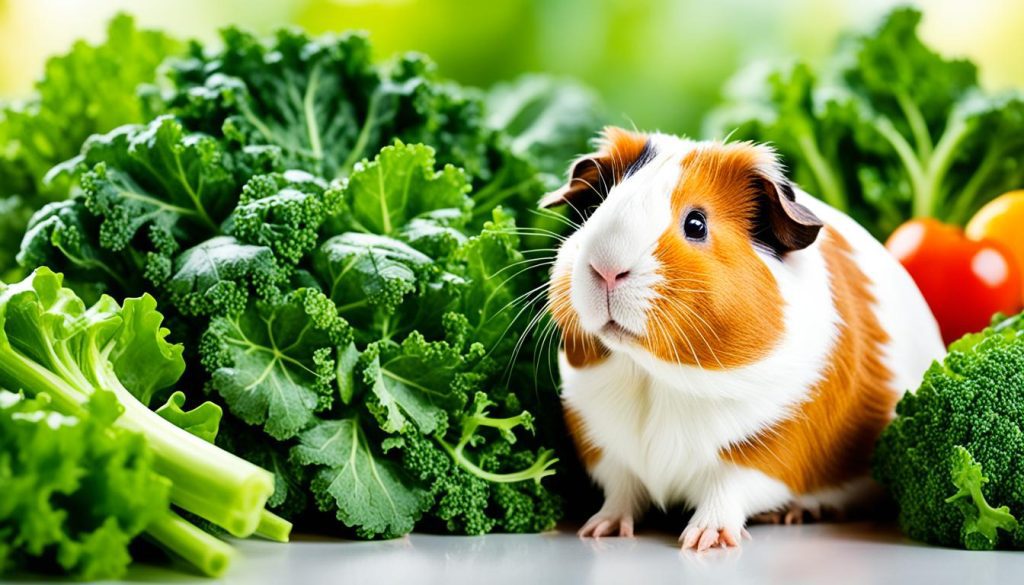
| Benefits of Kale for Guinea Pigs | Downsides of Kale for Guinea Pigs |
|---|---|
| Supports overall health | High calcium content can contribute to bladder stones |
| Boosts immune system | Overconsumption can lead to excessive vitamin A intake |
| Improves eyesight | Monitoring physical condition is necessary |
Feeding Guidelines for Guinea Pigs
When it comes to feeding kale to guinea pigs, it is important to follow the recommended guidelines to ensure their nutritional needs are met without any adverse effects. Guinea pigs should be fed kale in small amounts as part of a balanced diet that includes a variety of vegetables and hay. Here are some feeding guidelines to keep in mind:
- Portion Size: The recommended serving size of kale for guinea pigs is a leaf or two of average-sized fronds. This helps prevent overconsumption of kale and ensures they receive the nutritional benefits without any negative consequences.
- Frequency: Kale can be offered to guinea pigs two to three times a week. This allows for variety in their diet while avoiding excessive intake of kale.
- Monitoring: It is important to monitor your guinea pig’s waste output when feeding kale. If you notice any changes or unusual behavior, it may be an indication that the amount of kale being fed needs to be adjusted.
Remember, kale should not be the sole component of a guinea pig’s diet. It is essential to provide them with a well-rounded nutrition by including other vegetables and hay in their daily meals. Maintaining a balanced diet is key to their overall health and well-being.
Feeding Guidelines Table
| Feeding Guidelines for Guinea Pigs | Recommended Amount | Frequency |
|---|---|---|
| Kale | A leaf or two of average-sized fronds | Two to three times a week |
| Other Vegetables | Varies based on the type of vegetable | Daily |
| Hay | Unlimited supply | Daily |
| Pellets | 1/8 cup per day | Once daily |
By following these feeding guidelines, you can ensure that your guinea pig receives the right amount of kale and other essential nutrients for a healthy diet.
Other Vegetables for Guinea Pigs
Along with kale, guinea pigs can enjoy a variety of other vegetables in their diet. Adding different vegetables not only provides nutritional variety but also makes mealtime more interesting for your furry friend. Here are some safe vegetables for guinea pigs to enjoy:
- Romaine Lettuce
- Mustard Greens
- Cilantro
- Red and Green Peppers
- Broccoli
- Carrots
- Zucchini
These vegetables offer a range of flavors, textures, and nutrients that can keep your guinea pig happy and healthy. Including a mix of leafy greens, crunchy vegetables, and vibrant colors will provide optimal nutrition for your pet.
Remember to introduce new vegetables gradually, especially if your guinea pig hasn’t tried them before. This helps minimize the risk of digestive upset and allows their system to adjust to the new food. It’s also important to monitor their digestion and overall well-being when introducing new vegetables to ensure they tolerate them well.
One way to keep your guinea pig’s meals interesting is by creating a veggie medley. You can combine two or more of the vegetables mentioned above to create a colorful and nutritious mix. This adds variety to their diet and helps prevent boredom or picky eating habits.
Offering a fresh variety of safe vegetables for guinea pigs ensures that they receive a well-rounded diet and enjoy a range of flavors and textures to keep mealtime exciting.
Comparison of Nutritional Content in Select Vegetables
| Vegetable | Vitamin A (IU/100g) | Vitamin C (mg/100g) | Calcium (mg/100g) |
|---|---|---|---|
| Romaine Lettuce | 4024 | 9.2 | 33 |
| Mustard Greens | 3174 | 70 | 144 |
| Cilantro | 3935 | 27 | 67 |
| Red Bell Pepper | 1577 | 127.7 | 10 |
| Broccoli | 623 | 89.2 | 16 |
| Carrots | 16706 | 5.9 | 33 |
| Zucchini | 200 | 17.9 | 16 |
Importance of Hay and Commercial Food in Guinea Pig Diet
When it comes to the dietary needs of guinea pigs, two essential components play a significant role in their overall health and well-being: grass hay and commercial food. These two elements work together to provide the necessary nutrients for a balanced diet.
The Benefits of Grass Hay
Grass hay, such as timothy or orchard hay, should make up around 80% of a guinea pig’s daily intake. Hay not only aids in digestion but also helps maintain dental health. The constant chewing and grinding that hay requires help wear down their ever-growing teeth, preventing dental issues that can cause pain and discomfort. Additionally, the high fiber content in hay promotes a healthy digestive system and prevents gastrointestinal problems.
Guinea pigs, like many other small mammals, have a unique digestive system that relies on a constant supply of fiber. Without enough fiber, they can suffer from digestive issues like diarrhea or even fatal conditions like gastrointestinal stasis. Therefore, providing a generous amount of grass hay is crucial in supporting their digestive health.
The Role of Commercial Food
While grass hay is the foundation of a guinea pig’s diet, commercial food supplements their nutritional needs and provides essential vitamins and minerals. Timothy-based pellets fortified with vitamin C are particularly beneficial for guinea pigs, as they require a daily intake of this vital nutrient to stay healthy.
Commercial food pellets should be given in limited amounts to ensure that guinea pigs still prioritize hay as their primary food source. A small handful of pellets per day is sufficient to meet their nutritional requirements.
It’s important to note that not all commercial guinea pig foods are created equal. Look for high-quality brands that do not contain added sugars or artificial additives. Reading the ingredient list and choosing products that prioritize natural and wholesome ingredients will ensure your guinea pig receives the best nutritional value.
Creating a Balanced Diet
A balanced guinea pig diet consists of a combination of grass hay, commercial food, and fresh vegetables. To provide a well-rounded nutrition plan:
- Offer fresh grass hay daily, ensuring a constant supply for nibbling and digestion.
- Introduce a small amount of commercial food pellets daily, choosing those high in nutritional value and vitamin C content.
- Provide a variety of fresh vegetables, such as leafy greens, peppers, and carrots, to supplement their diet with additional vitamins and minerals.
By incorporating these components into their daily meals, you’ll be providing your guinea pig with a healthy and balanced diet that meets their nutritional needs.
To give you a better understanding of the recommended daily intake of hay and commercial food for guinea pigs, here is a brief table:
| Foods | Portion Size | Frequency |
|---|---|---|
| Grass Hay | Unlimited | Throughout the day |
| Commercial Food | 1/8 cup (about 1 tablespoon) | Once daily |
Remember to always consult with your veterinarian for personalized feeding guidelines based on your guinea pig’s specific needs and health condition.
Fruit as Occasional Treats for Guinea Pigs
When it comes to guinea pig snacks, fruit can be a delightful option. However, it’s important to remember that fruit should be given to guinea pigs as occasional treats due to their high sugar content. This ensures that their overall diet remains balanced and promotes their overall well-being.
Kiwis, strawberries, and citrus fruits are particularly good choices for guinea pigs as they contain high levels of vitamin C, which is essential for their health. Vitamin C helps to boost their immune system and supports healthy growth.
While it’s tempting to give your furry friend big chunks of juicy fruit, portion control is key. Guinea pigs have delicate digestive systems and consuming too much fruit can lead to diarrhea. Therefore, it’s crucial to offer small servings of fruit to guinea pigs.
Feeding Guidelines for Fruit Treats
When introducing new fruits to guinea pigs, it’s best to do so gradually. Start with small amounts and monitor their digestion and overall health. If they show any signs of discomfort or digestive issues, it’s important to stop giving them that particular fruit and consult a veterinarian.
Here are some feeding guidelines for offering fruit as treats to guinea pigs:
- Give small portions of fruit, about the size of a teaspoon, 1-2 times a week.
- Alternate between different fruits to provide variety in their diet.
- Remove any uneaten fruit after a few hours to prevent spoiling.
Remember, while fruit treats can be a source of joy and enrichment for your guinea pig, their main diet should consist of hay, fresh vegetables, and balanced guinea pig pellets. These provide essential nutrients and fiber necessary for their overall health and well-being.
Keep your guinea pig’s happiness in mind by offering them fruit treats in moderation, and they’ll be sure to squeak with delight!
| Fruits | Vitamin C Content (per 100g) |
|---|---|
| Kiwis | 92 mg |
| Strawberries | 58 mg |
| Citrus fruits (oranges, tangerines) | 53 mg |
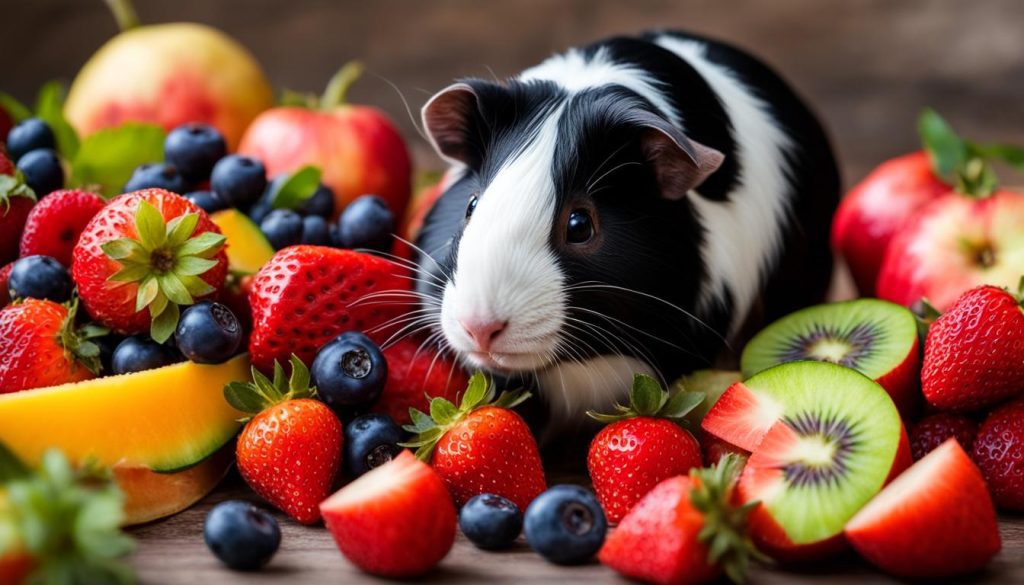
Conclusion
The inclusion of kale in a guinea pig’s diet can be safe and beneficial, provided it is given in moderation. Kale is a nutritious leafy green that provides essential vitamins and nutrients for the overall health of guinea pigs, such as vitamin A, vitamin C, and calcium.
However, it is important to avoid overfeeding kale to guinea pigs due to the potential risks of excessive calcium and vitamin A intake. This can lead to bladder stones and toxicity, which can be harmful to their well-being. Therefore, it is crucial to maintain a balanced diet that includes a variety of vegetables, grass hay, and high-quality commercial food.
By monitoring the physical condition of guinea pigs and adjusting their diet accordingly, we can ensure that they receive the proper nutrition they need. It is also essential to introduce new vegetables gradually, monitor their digestion, and provide fresh water at all times. A well-rounded diet and proper care will contribute to the overall health and happiness of these beloved pets.

